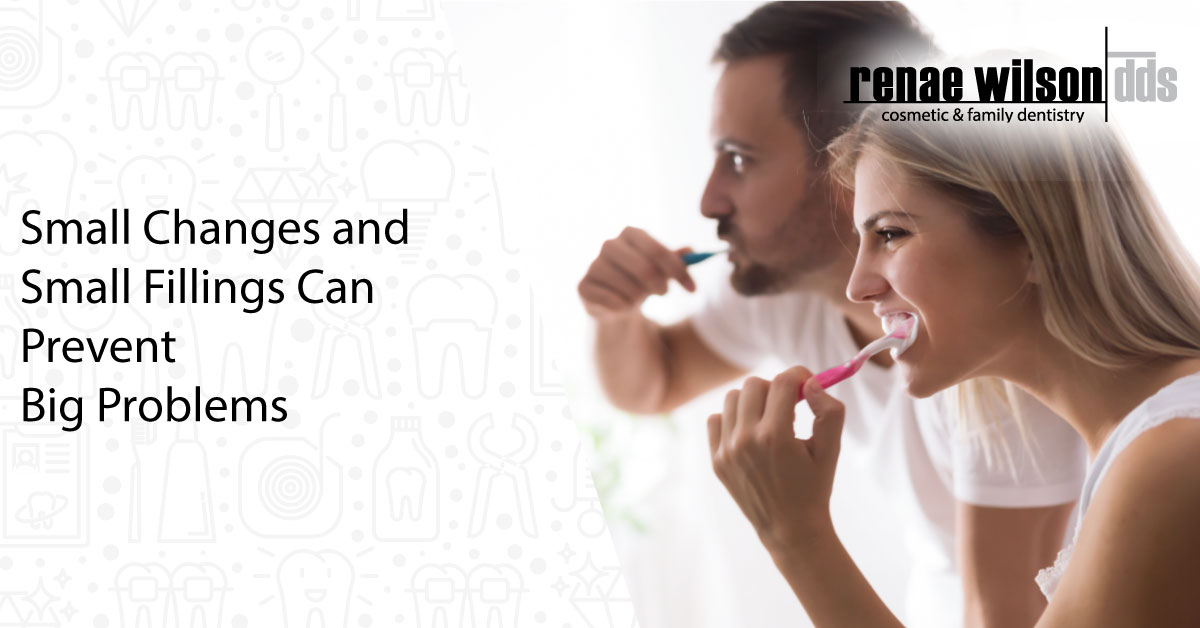
21 Jan Small Changes and Small Fillings Can Prevent Big Problems
The holiday season with its festivities of sugar is behind us. Like many, you’ve now recalibrated to a healthier lifestyle. You’re exercising and eating only good fats and above-ground veggies. The only candy in your house is something stuck to the bottom of your shoe. You brush and floss with a vengeance.
You’ve made it a couple weeks. Then, PING! A tooth sends you a shot of pain. Your teeth are telling you they have thin trust in this new lifestyle. And those little shots of pain are telling you to
- Focus on small, sustainable changes.
- See your dentist.
Don’t Bite Off More Than You Can Chew
Make small changes. You may have decided to get rid of all sugar. Admirable goal! I can hear your tooth enamel clicking its approval from here! But cold turkey is tough. According to one often-cited study, sugar has behavioral and neurochemical effects similar to other addictive substances. So, don’t be surprised if your zero-sugar weeks end at a Dunkin Donuts’ parking lot where you sit alone in your car, wolfing down a half-rack of glazed sugar bombs.
Start small.
- If you have a soda or sugary drink habit, start there. Why? Studies are clear. Sugary drinks cause dental caries and enamel erosion. Not to mention the other health problems they cause.
- Drink water instead. The minerals in water strengthen tooth enamel. Water also washes away the flotsam and jetsam that harmful bacteria love to munch. Those bacteria then leave behind plaque, which changes the pH in your mouth, allowing the acids they discard to erode your enamel.
- Stop “eating sticky.” When you do assuage a rough day with a candy treat, stay away from caramels, taffies, or anything that sticks to your teeth. That includes those seemingly “healthy” alternatives like raisins and chocolate covered dried fruits.
Get that Ping Checked Out Now!
A ping is nerve’s shot across the bow. When you have any tooth pain, ache, or sensitivity to temperature, it’s time to have your dentist check things out.
One high-tech diagnostics instrument we use is called DIAGNOdent®. Using a ray of fluorescent light, we measure the laser fluorescence within a tooth to see if and where enamel is eroding. It’s that simple. And that painless.
If it’s not yet a cavity, your enamel may be still be weakened. Here are things you can do to strengthen your enamel.
- Keep working on those lifestyle changes! Limit snacks, sweets, and drinks that cause acid attacks on your enamel.
- Visit our hygienist every six months.
- Use fluoridated toothpaste, and make sure you use a soft-bristled toothbrush.
- Brush and floss in the morning and evenings.
- Spare your teeth their previous roles as ice crushers, scissors, or pliers.
If it’s a small cavity, don’t despair. By detecting a cavity when it’s still small, we can fix it and stop the progression of decay easily and quickly. And small cavities are important to attend to, for if they are not stopped, they can further penetrate the tooth, affecting the tiny nerve fibers in the dentin. That will inevitably lead to more pain and possible infections or even an abscess. Fillings halt that process and save you pain, money, and possibly a tooth.
Plus, if you’re a person with a small cavity, you may not even need a numbing shot! Many small cavities can be filled with a quick zip-zip of a micro-drill without the need of a local anesthetic. Everything is quick and painless.
Here are two types of fillings used to treat small cavities:
- Composite fillings. Composite resin fillings can be matched to the natural shade of your tooth color. This type of filling requires minimal drilling, so the natural tooth is preserved.
- Ionomer fillings. Ionomer fillings are practically invisible once placed. Used only on very small cavities, especially cavities affecting teeth roots, Ionomer fillings require very little drilling compared to other types of fillings.
We are experienced at determining the best filling for each patient’s needs. We talk you through each step and ensure you are comfortable with each decision.
If you have pain, make an appointment. We’ll get to the bottom of it and set you back on the healthy track you’ve established for yourself. Healthy changes take small steps, a few tweaks now and then, and support. We’re here to help you with all of that!


